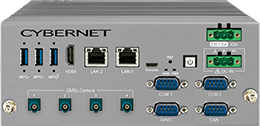The modern world's ever-growing demand for new products, from smartphones to electric cars to robots, has put increased pressure on the mining industry to obtain the raw materials to make them: rare earths, minerals, and metals. In response, companies are turning to mining technology like rugged mini PCs to meet these demands as well as reap benefits like reducing their environmental impact and increasing worker safety.
What is Mining Technology?
Mining technology or mining tech refers to the equipment, machinery, and tools used to extract geological materials from the earth. Bulldozers, mining drills, excavators, wheel loaders, and other forms of heavy machinery are some of the most recognizable examples of mining technologies.
Mining tech is far more expansive today, adding computer technologies and advanced processes like sensor-based ore sorting. Safety tools, techniques, and methods to protect mine workers also fall under the definition, with much of the equipment similar to the gear used and worn by oil rig workers.
Today's mining companies have access to a slew of tech, including:
- Artificial intelligence (AI) housed in industrial AI box PCs where they collect and process data from sensors and other forms of data-gathering instruments from mining sites.
- Automating machinery like drilling systems, ventilation equipment, and long-distance trains to work around the clock and in hazardous areas and situations.
- Drones and other unmanned aerial systems to perform visual surveys in hard-to-reach areas like above the site or deep within the tunnels.
- Global Positioning Systems (GPSs) to accurately map out current and potential mining sites.
- Geographic information systems (GISs) to figure out how the mining operations, such as runoff wastewater into the local rivers and streams, could be affecting the surrounding environment,
- Wearable mining tech such as smart glasses, smart helmets, and wearable sensors to track workers to ensure they don't enter hazardous areas and can be found quickly in the case of an accident.
- Virtual reality (VR) to train new workers by simulating dangerous mining operations and processes like explosive placement safely.
Benefits of Tech in Mining
Mining tech provides many benefits throughout the industry.
Increased Productivity: Mining companies are using technology to make their operations more efficient. Artificial intelligence, as mentioned earlier, can take the massive amounts of data gathered at mining sites and process them for everything from reducing downtime and lowering equipment failure to boosting labor productivity and improving overall mine efficiency.
Improved Safety: Mining is a dangerous job. To improve worker safety, mining tech like smart sensors can continuously monitor site conditions like temperature and oxygen levels. Workers can be tracked in real-time by wearables, while self-driving land rovers and similar automated mining machinery can perform truly dangerous operations so that the miners don't have to.
Higher throughput: Throughput is the amount of tons of ore that can be extracted from a deposit over a period of time. Mining organizations can use analytics systems to handle multiple sites worldwide, ensuring each one performs at maximum efficiency and profitably.
Fewer Operating Costs: Automated mining technologies, like drones to haulers to fleet management systems, can work continuously and precisely for long stretches of time. This, in turn, reduces labor and maintenance expenses.
Minimized Environmental Harm: The mining industry is under pressure in many countries to reduce its environmental impact, which includes carbon emissions, water waste, and the use of toxic chemicals. Battery-driven mining equipment, bacteria to dissolve ore, and other forms of "green mining" are being used to meet these numerous goals.
New job opportunities: Mining tech has opened up forms of work in the industry beyond the traditional miner. Workers skilled in software design, GIS mapping, data processing and analysis are needed to handle the technologies. Mining operations have also increased the scale of their operations thanks to tech, resulting in even more jobs to fill.
How to Choose the Right Computer for Mining
For mining companies, selecting the right equipment includes meeting the needs and conditions of the site. Computers, which are the heart of much of modern mining technology, must be able to withstand the harsh conditions of the site. They should have features such as:
- Military-grade components to withstand extreme temperatures, shock, and vibration.
- Fanless design is to keep cool and more reliable since they don't have moving parts, nor do they bring in dust and liquids into the PC or rugged industrial tablet's interior to damage it. The front bezel of the computer should have Ingress Protection (IP) of 65 or higher to provide similar protection.
- Legacy ports like PS/2 or serial ports to allow modern computers to connect with older mining equipment and access their data.
Let Cybernet Computers Run Your Mining Tech
The mining industry literally digs up the raw materials needed to meet modern society's ever-growing demand for products. Mining tech helps mining operations keep up with this demand and meet other requirements like being environmentally friendly to lowering costs to worker safety.
Contact the team at Cybernet Manufacturing if you are looking for computers for your mining operations. Our team members will happily discuss the numerous features that make our rugged mini PCs, rugged industrial tablets, and industrial panel PCs the right solution for your business. And as an Original Equipment and Design Manufacturer, we can further customize our products to meet your exact wants and needs.
Join the conversation and connect with us on this and other relevant topics - Follow us on Facebook, Twitter, Instagram, LinkedIn, TikTok, and YouTube.


